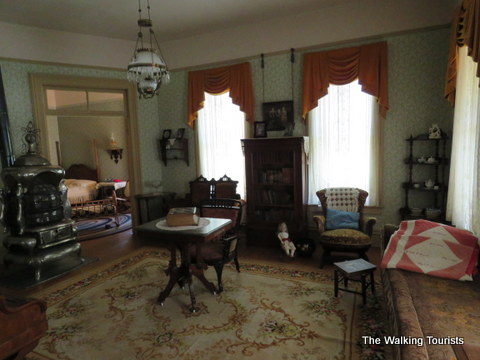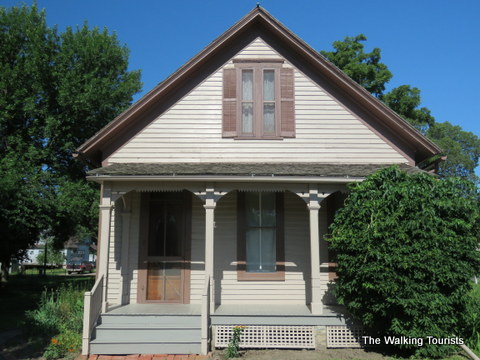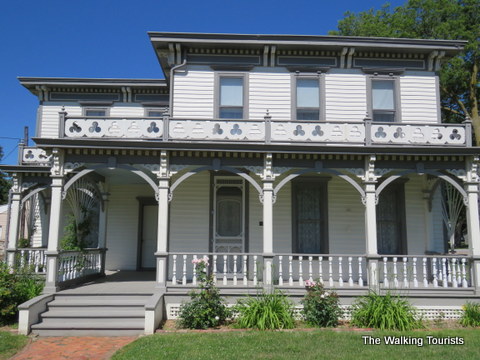Red Cloud tour gives inside look at Willa Cather’s stories
My daughters tease me, but I love seeing places where historical figures lived or worked. I’ve seen the homes of President Abraham Lincoln, Bill Clinton, Dwight Eisenhower and Harry Truman. I’ve the seen the homes or hometowns of Samuel Clemons (Mark Twain), JC Penney, General John J. Pershing, Buffalo Bill Cody and Henry Fonda.
Now, I can add the home of Willa Cather. Cather was the Nebraska author who wrote great novels about life on the prairie, including “O Pioneers!,” “My Antonia” and “The Lost Lady.” She won a Pulitzer Prize for “One of Ours,” in 1922.
We took in the seven-building tour offered by the Willa Cather Foundation in Red Cloud. It covers buildings that were key to Cather’s life or in her novels.
We started with a stop at Cather’s childhood home. The house, built in the late 1800s, is listed on the National Register of Historic Places.
Cather lived here for about seven years. The family moved to town, after living at the Divide, outside of Red Cloud. Her father farmed for a couple of years after moving to Nebraska from Virginia. He started a farm loan business when they moved to town.
The family rented the house for about 20 years, before buying the second house they lived in. it was a nice-looking house.
Some of the items in the house actually belonged to the Cathers. Other pieces in the house are from the era they lived.
Cather’s maternal grandmother had a bedroom on the first floor of the house, just off the dining room.

Willa had her own room in the attic. She was a vociferous reader, so it was common to see piles of books on her night table. She would look out the window to see the world. She decorated her room with wallpaper from the money she earned helping Dr. Cook, the local pharmacist. The wallpaper design remains today.

Her bedroom was the model for Thea Kronborg’s room in “Song of the Lark.” Her grandma’s room was included in “Old Mrs. Harris.”
Her brothers shared a larger room in the attic. They slept “dormitory style,” with the beds lined up in a row.
The kitchen includes some of the actual canned goods from the family’s life.
The house still has the Bittersweet vine that was included in a family portrait of the Cathers.
The family had a working water pump with a fresh water well just outside.
Cather loved Hollyhocks. The flowers still grow along the side of the house.
The next stop on the tour was the Red Cloud train depot. During the early days, communities lived and died by the railroad. Red Cloud was one of the fortunate towns to have a depot.
The depot was built in 1897 and was situated on the main line of the Burlington and Missouri, which ran between Kansas City and Denver.
Cather knew she’d leave Red Cloud one day. She took the train to Lincoln, where she studied at the University of Nebraska. After college, she eventually made her way east to Pittsburgh, where she worked in newspaper and later had a career as an editor before launching her novel writing.
A popular house to visit on the tour is the “Harling House” from “My Antonia.” It is based on the actual Miner House. The Miners employed a young Czech girl – Annie Pavelka – to care for the house.
The house was built in 1878. Willa was friends with the Cather children, and had a special friendship with Carrie Miner.
A visit to St. Juliana Falconieri Catholic Church was truly a step back in time. It was built in 1883 and served as a church until 1903, when it was converted into a private residence. It’s now operated by the Cather Foundation.
The church didn’t have a priest assigned, so one would visit to deliver mass. As he arrived by train, the engineer would sound a special whistle code to alert locals it was time for mass.
Cather would attend mass, even though she wasn’t Catholic, so she could learn Latin, which used then for mass.
The church was located in the lower class area of town. The “poor man’s stained glass” windows exemplify the economic divide of the community at the time.
Annie Pavelka had her baby baptized here and was later married in the church.
The Cathers were members of the local Grace Episcopal Church. Though Willa had left Red Cloud by then, she also was a member and would attend services when she was in town. The church still hosts a memorial service on the anniversary of her death (April 24, 1947).
Cather sponsored two of the custom painted windows, in honor of her parents. The church’s windows aren’t stained glass. They were hand painted. Originally handled by a German company, a St. Louis company can now do the work. The hand rail near the altar was imported from Spain and was sponsored by Cather in memory of her brother Douglass.
Built in 1888, the Farmers and Merchants Bank was once known as the Garber Bank. It was owned by Silas Garber, who is credited with founding Red Cloud in 1871.
Garber wasted no money in designing the building. The red stone near the foundation was carved from the red rocks at Garden of the Gods in Colorado. The teller windows were brought in from Chicago.
Garber experienced ups and downs in running the bank. The Garbers served as the inspiration for the characters in “A Lost Lady.”
The building now serves as part of the Cather historical site.
The final stop on the seven-building tour is the Opera House. Built in 1885, it’s still used for stage productions and concerts. Sarah Arneson, a world-renowned opera singer, will return to her home area in October for a special performance. The theater also hosts other musical acts and special exhibits.
Performers often sign their names one a wall behind the stage. The pop act Nelson Brothers (Gunnar and Matthew) visited in 2009 and signed the wall. The brothers – sons of 1950s singing sensation Ricky Nelson – enjoyed some success on the pop charts during the 1990s.
The Willa Cather Foundation is also located at the Opera House.
The Willa Cather National Center will open in 2016 next door to the Opera House. It will contain archives of the author’s work, shops, meeting space and apartments for visiting scholars to stay while they work on their local research.
The seven-building tour is well worth the time. The tour takes about 90 minutes. The information you learn along the way is priceless.
If you don’t have time for the full tour, you can take a three-building tour or a tour of the childhood home. Please contact the foundation to schedule a tour.
For more information, please visit the foundation’s website at www.willcather.org.
Disclaimer: Thank you to the Willa Cather Foundation for the complimentary tour. However, all opinions and views are ours.






























